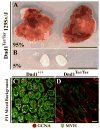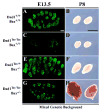BAX-mediated cell death affects early germ cell loss and incidence of testicular teratomas in Dnd1(Ter/Ter) mice
- PMID: 19389346
- PMCID: PMC2689365
- DOI: 10.1016/j.ydbio.2009.01.041
BAX-mediated cell death affects early germ cell loss and incidence of testicular teratomas in Dnd1(Ter/Ter) mice
Abstract
A homozygous nonsense mutation (Ter) in murine Dnd1 (Dnd1(Ter/Ter)) results in a significant early loss of primordial germ cells (PGCs) prior to colonization of the gonad in both sexes and all genetic backgrounds tested. The same mutation also leads to testicular teratomas only on the 129Sv/J background. Male mutants on other genetic backgrounds ultimately lose all PGCs with no incidence of teratoma formation. It is not clear how these PGCs are lost or what factors directly control the strain-specific phenotype variation. To determine the mechanism underlying early PGC loss we crossed Dnd1(Ter/Ter) embryos to a Bax-null background and found that germ cells were partially rescued. Surprisingly, on a mixed genetic background, rescued male germ cells also generated fully developed teratomas at a high rate. Double-mutant females on a mixed background did not develop teratomas, but were fertile and produced viable off-spring. However, when Dnd1(Ter/Ter) XX germ cells developed in a testicular environment they gave rise to the same neoplastic clusters as mutant XY germ cells in a testis. We conclude that BAX-mediated apoptosis plays a role in early germ cell loss and protects from testicular teratoma formation on a mixed genetic background.
Figures





Similar articles
-
MC4R mutant mice develop ovarian teratomas.Sci Rep. 2021 Feb 10;11(1):3483. doi: 10.1038/s41598-021-83001-w. Sci Rep. 2021. PMID: 33568756 Free PMC article.
-
Regulation of male germ cell cycle arrest and differentiation by DND1 is modulated by genetic background.Development. 2011 Jan;138(1):23-32. doi: 10.1242/dev.057000. Epub 2010 Nov 29. Development. 2011. PMID: 21115610 Free PMC article.
-
Mouse dead end1 acts with Nanos2 and Nanos3 to regulate testicular teratoma incidence.PLoS One. 2020 Apr 27;15(4):e0232047. doi: 10.1371/journal.pone.0232047. eCollection 2020. PLoS One. 2020. PMID: 32339196 Free PMC article.
-
What leads from dead-end?Cell Mol Life Sci. 2007 Jun;64(11):1317-22. doi: 10.1007/s00018-007-6433-3. Cell Mol Life Sci. 2007. PMID: 17464447 Free PMC article. Review.
-
The role of dead-end in germ-cell tumor development.Ann N Y Acad Sci. 2007 Dec;1120:181-6. doi: 10.1196/annals.1411.006. Epub 2007 Sep 28. Ann N Y Acad Sci. 2007. PMID: 17905939 Free PMC article. Review.
Cited by
-
Disruption of mitotic arrest precedes precocious differentiation and transdifferentiation of pregranulosa cells in the perinatal Wnt4 mutant ovary.Dev Biol. 2013 Nov 15;383(2):295-306. doi: 10.1016/j.ydbio.2013.08.026. Epub 2013 Sep 11. Dev Biol. 2013. PMID: 24036309 Free PMC article.
-
Left-Biased Spermatogenic Failure in 129/SvJ Dnd1Ter/+ Mice Correlates with Differences in Vascular Architecture, Oxygen Availability, and Metabolites.Biol Reprod. 2015 Sep;93(3):78. doi: 10.1095/biolreprod.115.128850. Epub 2015 Jul 29. Biol Reprod. 2015. PMID: 26224005 Free PMC article.
-
Mitotic arrest in teratoma susceptible fetal male germ cells.PLoS One. 2011;6(6):e20736. doi: 10.1371/journal.pone.0020736. Epub 2011 Jun 2. PLoS One. 2011. PMID: 21674058 Free PMC article.
-
Chemotherapy-Induced Depletion of OCT4-Positive Cancer Stem Cells in a Mouse Model of Malignant Testicular Cancer.Cell Rep. 2017 Nov 14;21(7):1896-1909. doi: 10.1016/j.celrep.2017.10.078. Cell Rep. 2017. PMID: 29141221 Free PMC article.
-
Deficiency of splicing factor 1 suppresses the occurrence of testicular germ cell tumors.Cancer Res. 2010 Sep 15;70(18):7264-72. doi: 10.1158/0008-5472.CAN-10-0820. Epub 2010 Aug 24. Cancer Res. 2010. PMID: 20736371 Free PMC article.
References
-
- Brown LM, Pottern LM, Hoover RN, Devesa SS, Aselton P, Flannery JT. Testicular Cancer in the United-States - Trends in Incidence and Mortality. International Journal of Epidemiology. 1986;15:164–170. - PubMed
Publication types
MeSH terms
Substances
Grants and funding
LinkOut - more resources
Full Text Sources
Medical
Molecular Biology Databases
Research Materials

